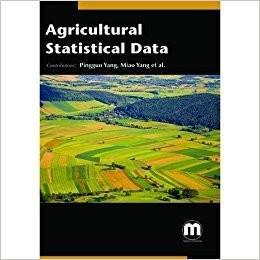
现货Agricultural Statistical Data[9781682500255]
¥ 1434 九五品
仅1件
上海宝山
认证卖家担保交易快速发货售后保障
作者Pingguo Yang, Miao Yang
出版社Magnum Publishing LLC
ISBN9781682500255
出版时间2016-01
装帧精装
纸张其他
正文语种英语
上书时间2023-08-08
- 最新上架
商品详情
- 品相描述:九五品
- 商品描述
- Agricultural Statistics is the branch of economic statistics that deals with agriculture and, as such, is an important tool for state management and planned guidance of socialist agricultural enterprises. The principal tasks involved in agricultural statistics are the collection, processing, and analysis of statistical data that characterize the current status and development of agriculture and the fulfillment of production plans. Such data are used to draw up yearly and long-range plans for agricultural production. The sources of information employed in agricultural statistics are censuses, sample surveys, and the periodic and annual reports submitted by kolkhozes, sovkhozes, and other state and cooperative agricultural enterprises, reports based on the data obtained from basic bookkeeping procedures and production accounting at such farms. Agricultural Statistical Data Analysis Using Stata introduces readers to the use of Stata to solve agricultural statistical problems. First chapter aims to analyze possible sources of heavy metals by multivariate statistical techniques and to assess soil heavy metal contamination using single pollution index and integrated pollution index to identify spatial distribution of single pollution index of soil heavy metal through geostatistical analysis. In second chapter, we present a novel forecasting method for generating agricultural crop yield forecasts at the seasonal and regional-scale, integrating agroclimate variables and remotely-sensed indices. Third chapter presents a comprehensive analysis of trends in aggregate production, cultivated area and farmgate value for 58 pollinator-dependent crops over an 18 year period. Fourth chapter presents a study investigating the NO3- and DOC concentrations in agricultural ecosystems during rainfall events. The objective is to determine NO3- fate by using a new stoichiometric method. Fifth chapter employs a chance-constrained data envelopment analysis (CDEA) approach with two models to decompose provincial productivity growth in Vietnamese agriculture from 1995 to 2007 into technological progress and efficiency change. The objective of sixth chapter is to develop Agroclimatic-Yield based regression models for estimation rain-fed cotton for Gharakhil district (Mazandaran Province, Iran) using available historical data. Seventh chapter investigates the statistical relationship between climatic variables and aspects of cotton production, and the effects of climatic factors prevailing prior to flowering or subsequent to boll setting on flower and boll production and retention in cotton. Eighth chapter shows how to generate different datasets from UNSODA, estimate the SWRPs in vG model on each dataset, and obtain more reliable statistical results with DE. Ninth chapter draws attention to the potential for probabilistic forecasting of the within-season component of nitrous oxide emissions from agricultural soils. Tenth chapter introduces an object-based approach to flood mapping and affected rice field estimation in central Cambodia. In eleventh chapter, we discuss several methodological extensions and data requirements to enable further statistical modeling and validation for improved agricultural decision-support. Twelfth chapter assess the performance of modis NDVI and EVI for seasonal crop yield forecasting at the ecodistrict scale. In thirteenth chapter, we aim to qualify the crop classes of the MODIS Land Cover Product (LCP) in Sub-Saharan Africa using FAO (Food and Agricultural Organization) and AGRHYMET (Agriculture, Hydrology and Meteorology) statistical data of agriculture and a sample of 55 very-high-resolution images. The aim of fourteenth chapter is to evaluate the potential of various ground-level optical sensors and narrow-band indices obtained from airborne hyperspectral images as tools for developing N fertilizer recommendations for maize. Fifteenth chapter evaluates different procedures for the application of a semi-empirical model to derive time-series of Leaf Area Index (LAI) maps in operation frameworks. Sixteenth chapter aims to estimate the effect of soil texture on NO3?-N content in groundwater. The goal of last chapter is to assess the ability of Landsat and ancillary soil and terrain data to model accurately spring soil water content in semi-arid rangelands of the Northern Great Plains.
— 没有更多了 —
![现货Agricultural Statistical Data[9781682500255]](https://www0.kfzimg.com/sw/kfz-cos/kfzimg/17733071/84650e1c690d82de_b.jpg)

![Petrucci's General Chemistry: Principles and Modern Applications [9781292726137]](https://www0.kfzimg.com/sw/kfz-cos/kfzimg/17733071/f3b0e1ed1b0ac6e4_s.jpg)
![现货Materials and Technologies of Modern Production[9783036401683]](https://www0.kfzimg.com/sw/kfz-cos/kfzimg/17733071/5fd2824531e165d7_s.jpg)
![现货Introduction to Container Ship Operations and Onboard Safety[9781032155425]](https://www0.kfzimg.com/sw/kfz-cos/kfzimg/17733071/58b7ff43ef7909ee_s.jpg)
![现货Electrophosphorescent Materials and Devices[9789814877343]](https://www0.kfzimg.com/sw/kfz-cos/kfzimg/17733071/18cc1d77bcb7b488_s.jpg)
![现货Organic Semiconductors for Optoelectronics[9781119146100]](https://www0.kfzimg.com/sw/kfz-cos/kfzimg/17733071/24c85a750c708964_s.jpg)
![现货Advances in Food Rheology and Its Applications[9780081004319]](https://www0.kfzimg.com/sw/kfz-cos/kfzimg/17733071/e0c11603c9119d4d_s.jpg)
![现货Advanced Materials and Sustainable Technologies[9783035727562]](https://www0.kfzimg.com/sw/kfz-cos/kfzimg/17733071/dced675333874c48_s.jpg)
![现货Advanced Materials and Manufacturing Engineering II[9783035712681]](https://www0.kfzimg.com/sw/kfz-cos/kfzimg/17733071/660ccfae75fa8d3e_s.jpg)
![现货Materials in Machinery and Construction[9783035718119]](https://www0.kfzimg.com/sw/kfz-cos/kfzimg/17733071/6f402060775e9daa_s.jpg)
![现货Agricultural Statistical Data[9781682500255]](/dist/img/error.jpg)
以下为对购买帮助不大的评价